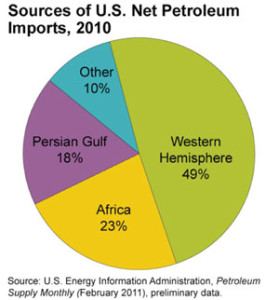Making informed decisions about energy requires understanding where energy comes from (sources) and how it is used.
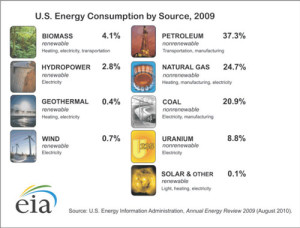 Primary Energy Sources
Primary Energy Sources
Primary energy sources are petroleum, coal, natural gas, nuclear fuel, and renewable energy. These primary fuels are used to make secondary sources of energy, like electricity. The top three primary energy sources consumed in the United States are petroleum (37 percent), natural gas (25 percent), and coal (21 percent). Primary energy sources are divided into two categories – renewable and nonrenewable.
Nonrenewable Sources
The top four primary energy sources in the United States are nonrenewable – coal, petroleum, natural gas, and uranium. Nonrenewable resources are those that cannot be replenished in a short time period (they are consumed faster than they are able to regenerate). They are extracted from the ground. 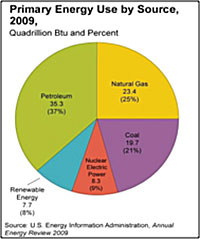 Fossil fuels (coal, oil, natural gas) fall into this category. Fossil fuels formed millions of years ago when plants and animals died, decomposed and were buried under layers of earth. Fossil fuels have high percentages of carbon.
Fossil fuels (coal, oil, natural gas) fall into this category. Fossil fuels formed millions of years ago when plants and animals died, decomposed and were buried under layers of earth. Fossil fuels have high percentages of carbon.
All fossil fuel sources are nonrenewable, but not all nonrenewables are fossil fuels. Uranium is a nonrenewable resource, but is not a fossil fuel.
Renewable Sources
Renewable energy sources regenerate and are sustained indefinitely. Sources of renewable energy include biomass, hydropower, geothermal, wind, and solar. Use of renewable energy is not new. Wind power was used for pumping water and grinding throughout ancient history. Wood (biomass) supplied 90 percent of United States energy needs more than 150 years ago. As the use of other resources expanded, reliance on renewable resources waned. Today, we are again looking for ways to incorporate renewable energy into our total energy portfolio, however renewable energy currently represents only 8 percent of our total energy source.
Sources and Uses
- Petroleum is the basis for oil products and gasoline production. Through refining, petroleum is converted into a variety of products, mostly related to transportation fuels.
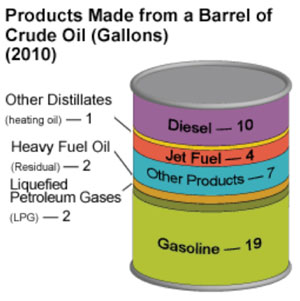 |
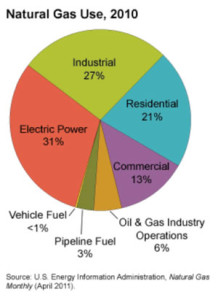 |
- Natural gas is used to heat slightly more than half of the homes in the United States, but 31 percent of the supply is also used to generate electricity. Natural gas is used in industrial manufacturing as an input in agriculture-related products, such as nitrogen fertilizers, and to make plastics.
- Ninety-three percent of coal production is used at power plants to generate electricity. Power plants burn coal to create steam in order to power electrical generators. Roughly half of the electricity
supply in the United States comes from coal. - Renewable energy makes up about 8 percent of U.S. total energy supply and was about 10 percent of the electricity supply in 2010. Hydropower is the largest renewable energy resource, representing 31 percent of the supply.
- Nuclear energy represents approximately 22 percent of the US electricity supply or about 8 percent of the total energy supply. Nuclear energy is created from uranium using nuclear fission.
Another way of considering sources and uses is in the graph below, which shows the primary sources of energy and the primary demand sectors (users) of energy in the U.S. This graphically illustrates many interesting things about the way we use energy. For example, we can see that 94 percent of our transportation fuels come from petroleum sources – meaning that we have few options to “switch” to other sources of supply when petroleum prices change or if the supply chain were compromised.
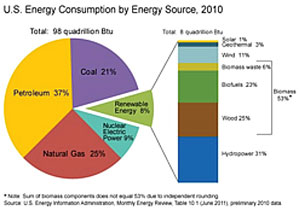 |
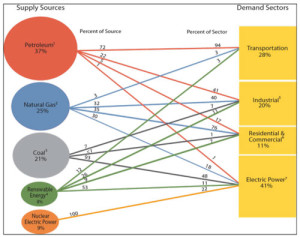 |
We can also see that only 3 percent of the transportation supply comes from renewable energy (biofuels). In addition, the graph shows that 93 percent of coal supply is used for electrical generation, but that coal is only 48 percent of the total supply for electrical power generation. This graph further shows that most renewable energy is related to electrical generation (either for electrical power production or in industrial or residential applications).
About Imported Sources of Energy
National independence is a common topic in today’s energy conversations. However, there are many misconceptions regarding our dependence on foreign sources of energy. Only 24 percent of total U.S. energy supply was imported in 2009. However, the US imports roughly 60 percent of its petroleum supply on an annual basis.
It may surprise you to learn where our imported petroleum is coming from. In 2010, 49 percent of imported petroleum came from the Western Hemisphere. Canada is our number one supplier of petroleum, but countries in Central and South America, as well as the Caribbean Islands provide almost half of our total supply. Even though Saudi Arabia is the second largest supplier of U.S. imported petroleum, the total Persian Gulf region accounts for 18 percent of total petroleum imports.
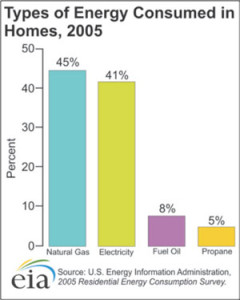
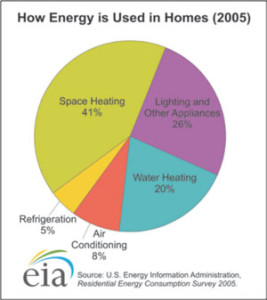 Energy Use in Homes
Energy Use in Homes
According to The U.S. Energy Information Administration, the type of energy consumed the most in U.S. homes is natural gas (45 percent). Most of the natural gas is used for space heating. Electricity comes in second at 41 percent. Most of the electricity is used for lighting and appliances.
The statistics are similar for homes in Montana and Wyoming. For Montana homes, the greatest amount of energy consumed is natural gas (44 percent). Most Montana and Wyoming homes heat living space with natural gas. It is used also for heating water. The second most common energy type is electricity at 32 percent of the total used.
Energy Use in Agriculture
Energy use varies by type of operation (poultry farm versus a dry land operation), so general averages are less meaningful when considering agricultural energy uses. There are several common areas of energy consumption in agriculture; however, the fuel types used may differ by operation. The categories of key agricultural energy consumptions include:
- Tractor and field operations,
- Irrigation systems,
- Indoor and outdoor lighting,
- Farm shop energy use,
- Livestock building energy use,
- Grain drying, and
- Livestock watering systems.
Of course, the home energy consumption of most agricultural operations is also significant.
Why does this information matter to me?
The relevance of the sources and uses of energy often relates to your objectives in exploring energy alternatives. For example, if your primary objective in making changes to your energy consumption is to reduce dependence on imported sources of energy, you should focus on reducing or producing transportation fuels. If your objective is to reduce fossil fuel consumption, you may wish to consider your largest use of fossil fuels as a place to start. Is personal consumption higher in transportation fuels or natural gas consumption for heating your home? Understanding what energy sources you are using and how those sources and uses relate to your objectives can help you to align your energy goals.
| Examples of Alternative Energy Sources that Address Current Energy Uses | |
| Current Energy Use | Alternative Energy Source |
| Electricity | Wind Turbine Photovoltaic Panel Micro-Hydro System Anaerobic Digester |
| Hot Water (Current source may be electric, gas, or propane) |
Solar Thermal System Concentrating Solar Power Technology/Parabolic Trough Geothermal (desuperheater) |
| Heated Air (Current source may be electric, gas, wood, or propane) |
Solar Air Collector Transpired Solar Collector Geothermal (Ground Source Heat Pump) Biomass Passive Solar Design |
| Transportation Fuel | Biofuel Renewable Electricity (for electric or hybrid vehicles) |


